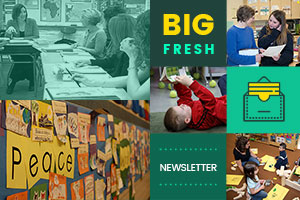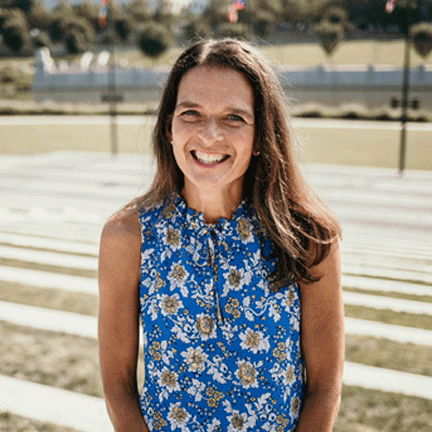Space is the breath of art.
—Frank Lloyd Wright
Seeing My Classroom Through a New Lens
As I got ready to enter Frank Lloyd Wright’s winter home and desert laboratory at Taliesin West in Arizona, I was caught off guard.
The doorway appeared simple, one hinged door with glass. As I got closer and reached for the handle, I thought I might have to duck. The roofline was almost my height. I didn’t need to duck, though.
I stepped in and felt squished. It felt like I was entering a cave or a small tunnel. My body tensed, yet after I took a few steps I relaxed because I entered a large room.
It was filled with windows, natural light, and wood. I turned around to look at the entrance I had just walked through and found the ceiling was at an angle and low to the floor. The angle of the ceiling indeed made this a smaller entrance.
As I listened to my audio-tour guide, I learned about a design technique Frank Lloyd Wright used known as compression and release. I nodded in agreement—I had felt the tension when I entered and then it released a few steps in. There was a moment of emotional energy from feeling two opposite things within seconds.
I listened intently to my audio-tour guide and noticed the things she was sharing about organic architecture. The room had large windows making it easier to view the landscape and sky. It was built using natural materials; rock, wood, bricks, and plants were strategically placed in the room.
As I walked outside and was asked to look at the beams on the roof, I learned that organic architecture uses the landscape and these lines on the building mimicked the mountain in the background. On another side of the building, beams were used to offer shade on a path and repetition was seen using the beams and space in between.
In most rooms I saw at Taliesin West, the perimeter had built-in chairs with square cushion seats and backs. It felt a bit odd with tables and chairs in the center of the perimeter seating. Frank Lloyd Wright called this democratic environments, which sent me to a Google search. I learned a democratic environment is really a gathering space for a community. I noticed these ideas as the tour continued in other rooms.
I was surprised when I thought about my classroom, since I was on a trip away from home in the middle of summer.
I realized my classroom has a democratic environment; we gather together as a community on our carpet space. Then I thought about how we sit on the carpet, considering what I had seen on the tour. I pondered Frank Lloyd Wright’s design ideas and my space. I embrace natural light, neutral colors, and natural materials, and I have plants around our space.
Then I questioned and will ponder further, “Does my space also create core principles of organic architecture? Are the form and function intertwined fostering connection and movement with the physical space and between the humans sharing this space?
I hope you will enjoy the series of videos featuring my classroom, mentioned below, and find a takeaway to try this year in your own classroom.
Mandy Robek
Third-Grade Teacher
Ohio

Mandy Robek has been teaching for over 30 years. She has taught kindergarten, first, second, and third grade, and currently teaches third grade, where she finds guiding readers and writers fascinating. Mandy has degrees from the State University of New York College at Buffalo and The Ohio State University. You can follow Mandy at her Substack Enjoy Embrace Learning and on Instagram @enjoy.embrace.learning.

Gwen Blumberg helps us consider and create space for a variety of personalities and learning needs. Inspired by a morning hike, she takes her observations and applies them to give space for all students to learn.
Youki Terada and Stephen Merrill provide a comprehensive and research-based look at effective learning spaces.
Wondrous Words: Reimagining Writers and Writing in the Elementary Classroom (NCTE, 2025) has been released! Katie Wood Ray and Stella Villalba have lovingly revised this masterpiece about teaching writers. Make sure to check out the book website to find free videos of Katie and Stella working with students.

New members-only content is added each week to the Choice Literacy website. If you’re not yet a member, click here to explore membership options.
Tara Barnett and Kate Mills remind us that more important than the physical layout of the classroom or the assessments we’ll give is the type of community we’ll become. Building a brave and enthusiastic community of learners is the foundation that everything else stands on. They share a community-building experience that can be adapted for any age.
Melissa Quimby challenged herself to unpack her identity as a teacher who listens. She discovered clear and repeatable actions that all educators can use to be intentional listeners. Schools become safer spaces when students feel heard. What new things might you try to create a safer space for children?
VIDEO | Mandy Robek shares a variety of seating choices students have in her classroom. She explains the reason for her choices and how she manages a classroom where no one has an assigned seat.
By the time they reach high school, many students have learned how to survive change, but not always how to make sense of it. They’ve lost friendships, switched schools, experienced family transitions, or even dealt with grief. While they may not always talk openly about these experiences, they often find reflections of them in the books they read. Gretchen Schroeder continues her series about using literature to help students learn important social and relationship skills. She includes student work and a booklist.

New members-only content is added each week to the Choice Literacy website. If you’re not yet a member, click here to explore membership options.
We know how important principal-coach meetings are. Having a common system to follow gives a sense of cohesiveness and purpose and helps everyone participate effectively. Hannah Tills shares the process of creating a template with a standard agenda and space for meeting notes.
Stephanie Affinito reminds us that effective coaching is built on strong relationships. Try this challenge to see if you know your colleagues as well as you hope you do.
Jean Russell explains how a simple trick with a coaching calendar can build in more time and expectations for leadership growth.
Quote It:
There isn’t anyone you couldn’t learn to love once you’ve heard their story.
—Fred Rogers
That’s all for this week!



